University Report: PICO Formulation of a Clinical Question on Diabetes
VerifiedAdded on 2022/11/15
|6
|1361
|322
Report
AI Summary
This report focuses on formulating a clinical question using the PICO (Population, Intervention, Comparison, Outcome) framework, specifically addressing the treatment of Type 2 Diabetes. The student identifies the target population as diabetic patients aged 10-80, highlighting the prevalence of the disease in Australia. The intervention explored is physical activity, a common and cost-effective method for managing diabetes. The report compares physical activity with medication and dietary changes, citing various studies that support or contradict the effectiveness of each approach. The expected outcome of the intervention is the maintenance of blood glucose levels and improved quality of life for patients. The formulated clinical question is: 'Is physical activity alone likely to be an effective treatment for Type 2 Diabetes or it will give much better result when accompanied by medication?' The rationale for choosing the question is the conflicting evidence regarding the effectiveness of different interventions. The clinical relevance is emphasized by the high mortality rate associated with diabetes and the need for effective interventions to reduce the health burden. The report references several studies supporting the chosen interventions and outcomes.
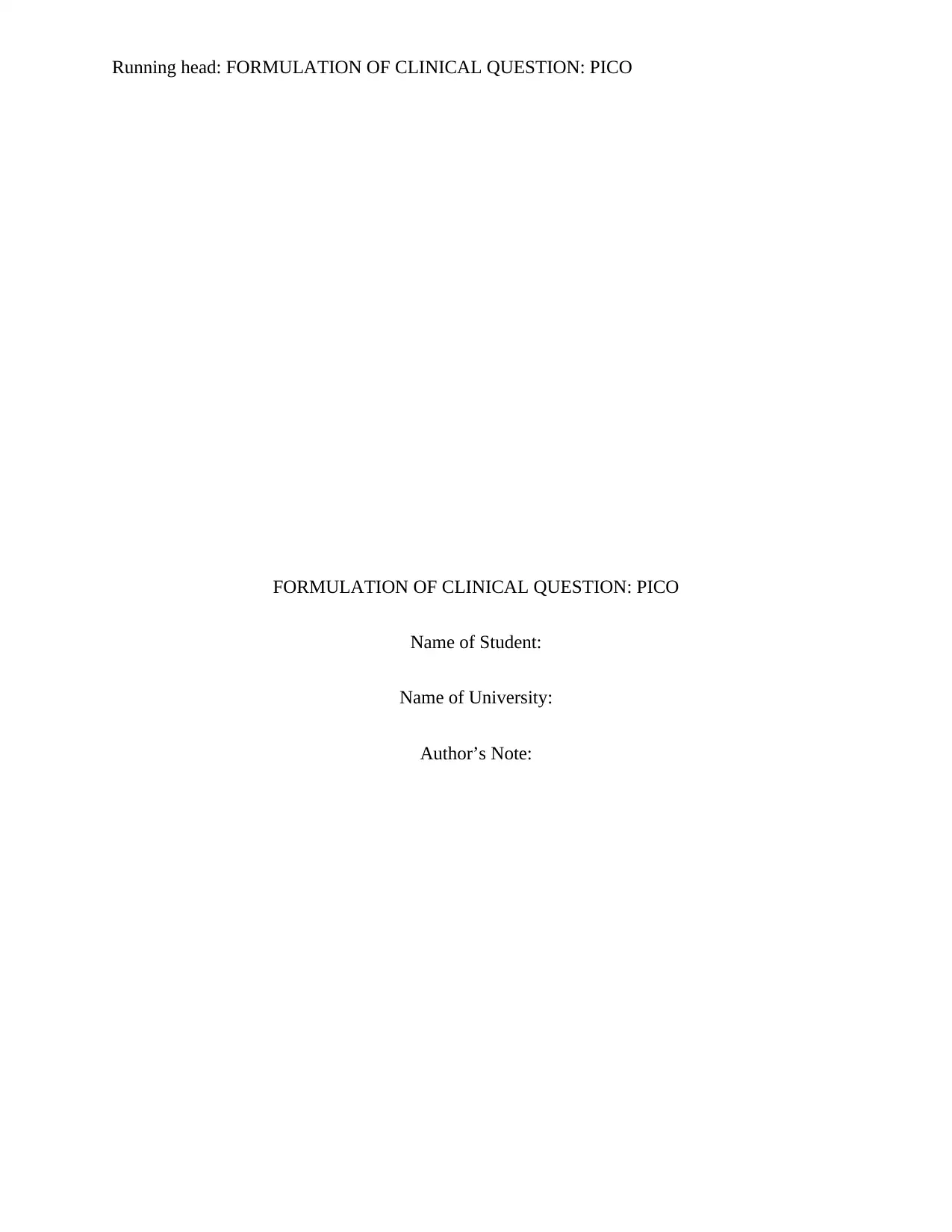
Running head: FORMULATION OF CLINICAL QUESTION: PICO
FORMULATION OF CLINICAL QUESTION: PICO
Name of Student:
Name of University:
Author’s Note:
FORMULATION OF CLINICAL QUESTION: PICO
Name of Student:
Name of University:
Author’s Note:
Paraphrase This Document
Need a fresh take? Get an instant paraphrase of this document with our AI Paraphraser
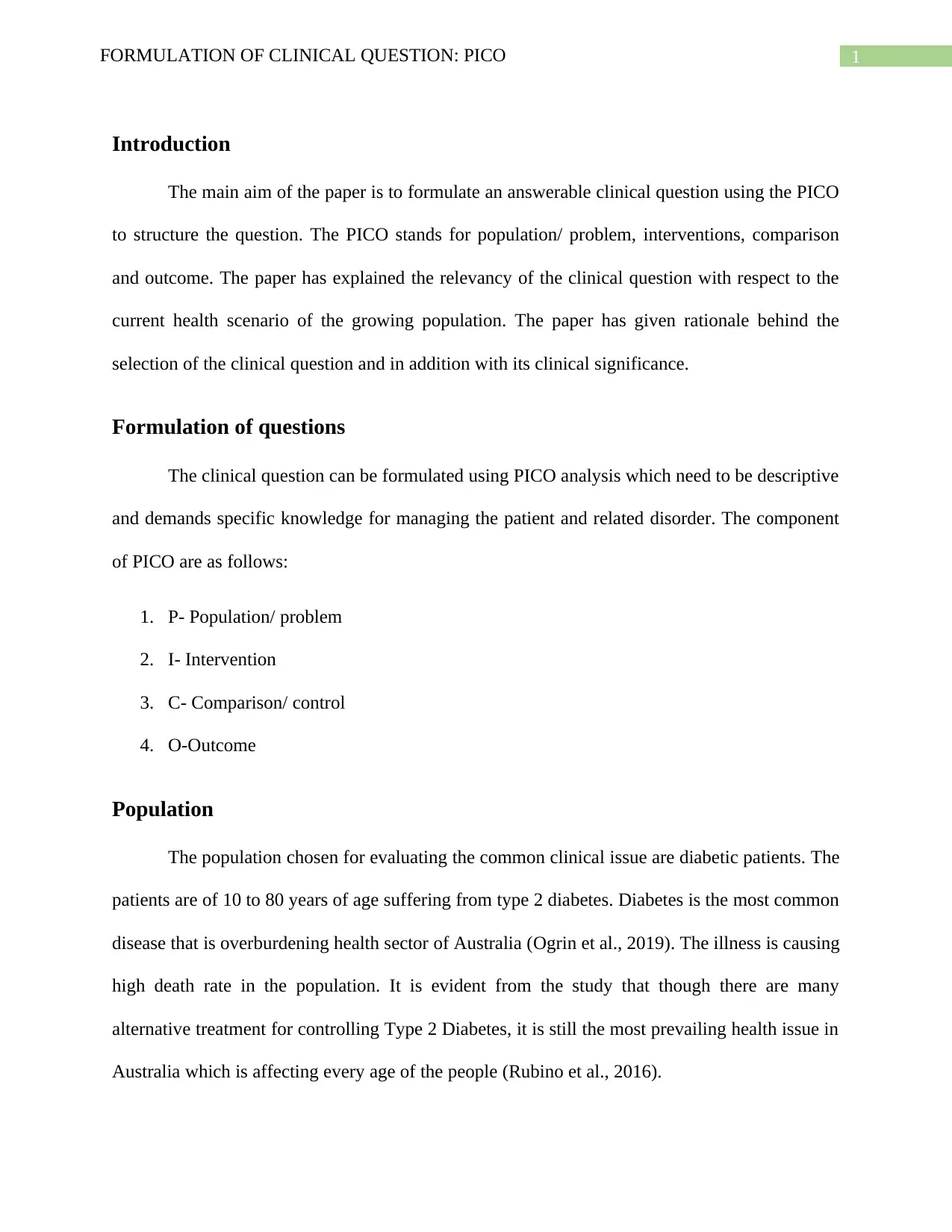
1FORMULATION OF CLINICAL QUESTION: PICO
Introduction
The main aim of the paper is to formulate an answerable clinical question using the PICO
to structure the question. The PICO stands for population/ problem, interventions, comparison
and outcome. The paper has explained the relevancy of the clinical question with respect to the
current health scenario of the growing population. The paper has given rationale behind the
selection of the clinical question and in addition with its clinical significance.
Formulation of questions
The clinical question can be formulated using PICO analysis which need to be descriptive
and demands specific knowledge for managing the patient and related disorder. The component
of PICO are as follows:
1. P- Population/ problem
2. I- Intervention
3. C- Comparison/ control
4. O-Outcome
Population
The population chosen for evaluating the common clinical issue are diabetic patients. The
patients are of 10 to 80 years of age suffering from type 2 diabetes. Diabetes is the most common
disease that is overburdening health sector of Australia (Ogrin et al., 2019). The illness is causing
high death rate in the population. It is evident from the study that though there are many
alternative treatment for controlling Type 2 Diabetes, it is still the most prevailing health issue in
Australia which is affecting every age of the people (Rubino et al., 2016).
Introduction
The main aim of the paper is to formulate an answerable clinical question using the PICO
to structure the question. The PICO stands for population/ problem, interventions, comparison
and outcome. The paper has explained the relevancy of the clinical question with respect to the
current health scenario of the growing population. The paper has given rationale behind the
selection of the clinical question and in addition with its clinical significance.
Formulation of questions
The clinical question can be formulated using PICO analysis which need to be descriptive
and demands specific knowledge for managing the patient and related disorder. The component
of PICO are as follows:
1. P- Population/ problem
2. I- Intervention
3. C- Comparison/ control
4. O-Outcome
Population
The population chosen for evaluating the common clinical issue are diabetic patients. The
patients are of 10 to 80 years of age suffering from type 2 diabetes. Diabetes is the most common
disease that is overburdening health sector of Australia (Ogrin et al., 2019). The illness is causing
high death rate in the population. It is evident from the study that though there are many
alternative treatment for controlling Type 2 Diabetes, it is still the most prevailing health issue in
Australia which is affecting every age of the people (Rubino et al., 2016).
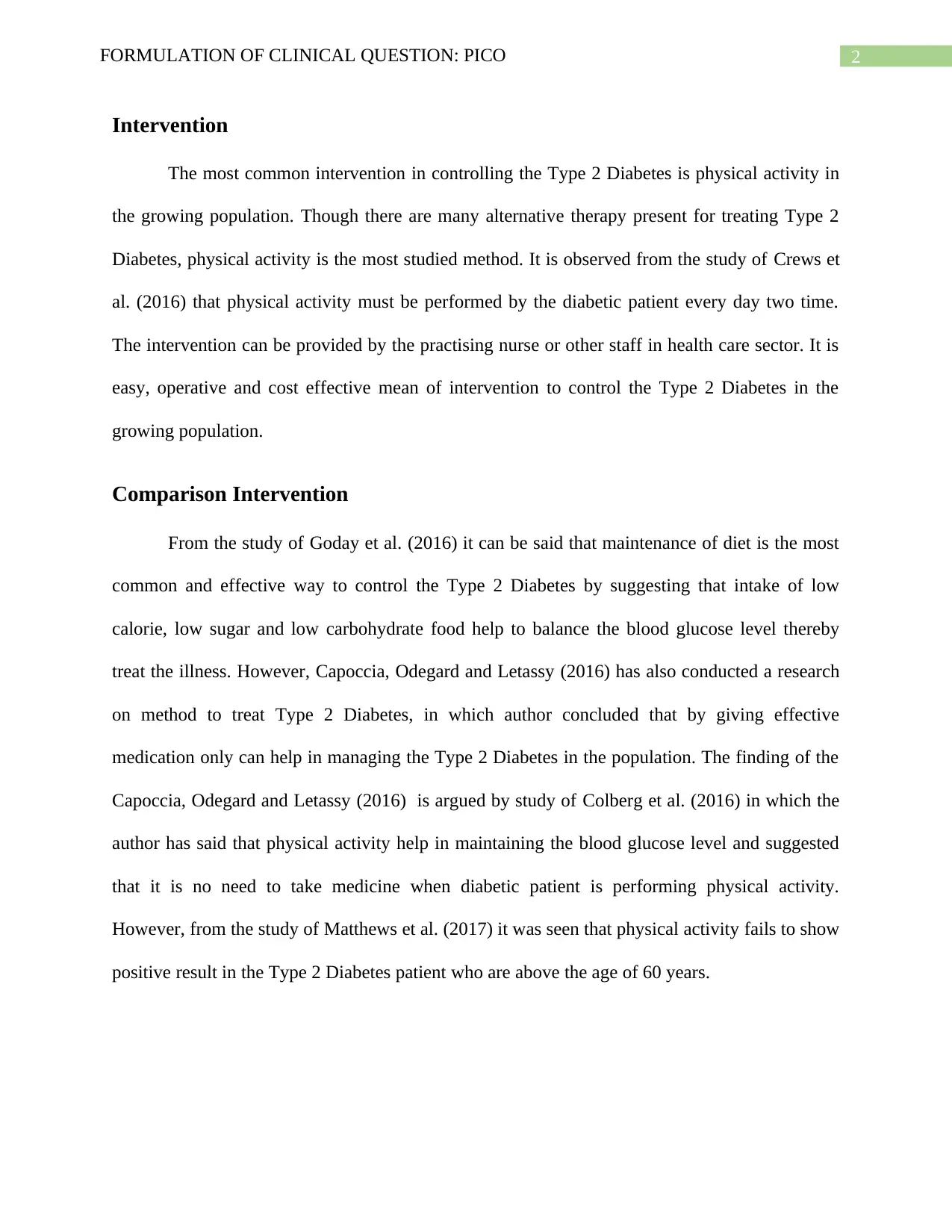
2FORMULATION OF CLINICAL QUESTION: PICO
Intervention
The most common intervention in controlling the Type 2 Diabetes is physical activity in
the growing population. Though there are many alternative therapy present for treating Type 2
Diabetes, physical activity is the most studied method. It is observed from the study of Crews et
al. (2016) that physical activity must be performed by the diabetic patient every day two time.
The intervention can be provided by the practising nurse or other staff in health care sector. It is
easy, operative and cost effective mean of intervention to control the Type 2 Diabetes in the
growing population.
Comparison Intervention
From the study of Goday et al. (2016) it can be said that maintenance of diet is the most
common and effective way to control the Type 2 Diabetes by suggesting that intake of low
calorie, low sugar and low carbohydrate food help to balance the blood glucose level thereby
treat the illness. However, Capoccia, Odegard and Letassy (2016) has also conducted a research
on method to treat Type 2 Diabetes, in which author concluded that by giving effective
medication only can help in managing the Type 2 Diabetes in the population. The finding of the
Capoccia, Odegard and Letassy (2016) is argued by study of Colberg et al. (2016) in which the
author has said that physical activity help in maintaining the blood glucose level and suggested
that it is no need to take medicine when diabetic patient is performing physical activity.
However, from the study of Matthews et al. (2017) it was seen that physical activity fails to show
positive result in the Type 2 Diabetes patient who are above the age of 60 years.
Intervention
The most common intervention in controlling the Type 2 Diabetes is physical activity in
the growing population. Though there are many alternative therapy present for treating Type 2
Diabetes, physical activity is the most studied method. It is observed from the study of Crews et
al. (2016) that physical activity must be performed by the diabetic patient every day two time.
The intervention can be provided by the practising nurse or other staff in health care sector. It is
easy, operative and cost effective mean of intervention to control the Type 2 Diabetes in the
growing population.
Comparison Intervention
From the study of Goday et al. (2016) it can be said that maintenance of diet is the most
common and effective way to control the Type 2 Diabetes by suggesting that intake of low
calorie, low sugar and low carbohydrate food help to balance the blood glucose level thereby
treat the illness. However, Capoccia, Odegard and Letassy (2016) has also conducted a research
on method to treat Type 2 Diabetes, in which author concluded that by giving effective
medication only can help in managing the Type 2 Diabetes in the population. The finding of the
Capoccia, Odegard and Letassy (2016) is argued by study of Colberg et al. (2016) in which the
author has said that physical activity help in maintaining the blood glucose level and suggested
that it is no need to take medicine when diabetic patient is performing physical activity.
However, from the study of Matthews et al. (2017) it was seen that physical activity fails to show
positive result in the Type 2 Diabetes patient who are above the age of 60 years.
⊘ This is a preview!⊘
Do you want full access?
Subscribe today to unlock all pages.

Trusted by 1+ million students worldwide
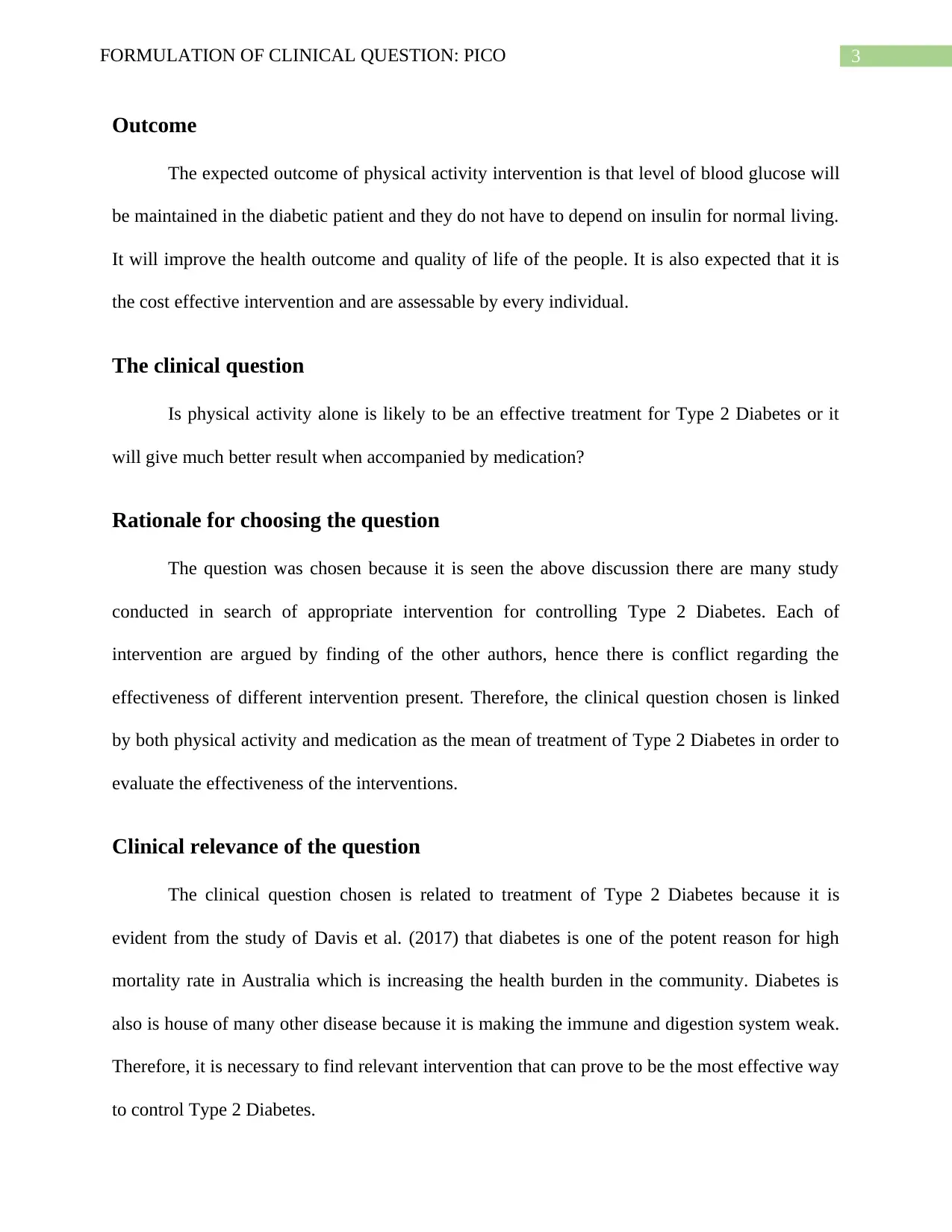
3FORMULATION OF CLINICAL QUESTION: PICO
Outcome
The expected outcome of physical activity intervention is that level of blood glucose will
be maintained in the diabetic patient and they do not have to depend on insulin for normal living.
It will improve the health outcome and quality of life of the people. It is also expected that it is
the cost effective intervention and are assessable by every individual.
The clinical question
Is physical activity alone is likely to be an effective treatment for Type 2 Diabetes or it
will give much better result when accompanied by medication?
Rationale for choosing the question
The question was chosen because it is seen the above discussion there are many study
conducted in search of appropriate intervention for controlling Type 2 Diabetes. Each of
intervention are argued by finding of the other authors, hence there is conflict regarding the
effectiveness of different intervention present. Therefore, the clinical question chosen is linked
by both physical activity and medication as the mean of treatment of Type 2 Diabetes in order to
evaluate the effectiveness of the interventions.
Clinical relevance of the question
The clinical question chosen is related to treatment of Type 2 Diabetes because it is
evident from the study of Davis et al. (2017) that diabetes is one of the potent reason for high
mortality rate in Australia which is increasing the health burden in the community. Diabetes is
also is house of many other disease because it is making the immune and digestion system weak.
Therefore, it is necessary to find relevant intervention that can prove to be the most effective way
to control Type 2 Diabetes.
Outcome
The expected outcome of physical activity intervention is that level of blood glucose will
be maintained in the diabetic patient and they do not have to depend on insulin for normal living.
It will improve the health outcome and quality of life of the people. It is also expected that it is
the cost effective intervention and are assessable by every individual.
The clinical question
Is physical activity alone is likely to be an effective treatment for Type 2 Diabetes or it
will give much better result when accompanied by medication?
Rationale for choosing the question
The question was chosen because it is seen the above discussion there are many study
conducted in search of appropriate intervention for controlling Type 2 Diabetes. Each of
intervention are argued by finding of the other authors, hence there is conflict regarding the
effectiveness of different intervention present. Therefore, the clinical question chosen is linked
by both physical activity and medication as the mean of treatment of Type 2 Diabetes in order to
evaluate the effectiveness of the interventions.
Clinical relevance of the question
The clinical question chosen is related to treatment of Type 2 Diabetes because it is
evident from the study of Davis et al. (2017) that diabetes is one of the potent reason for high
mortality rate in Australia which is increasing the health burden in the community. Diabetes is
also is house of many other disease because it is making the immune and digestion system weak.
Therefore, it is necessary to find relevant intervention that can prove to be the most effective way
to control Type 2 Diabetes.
Paraphrase This Document
Need a fresh take? Get an instant paraphrase of this document with our AI Paraphraser
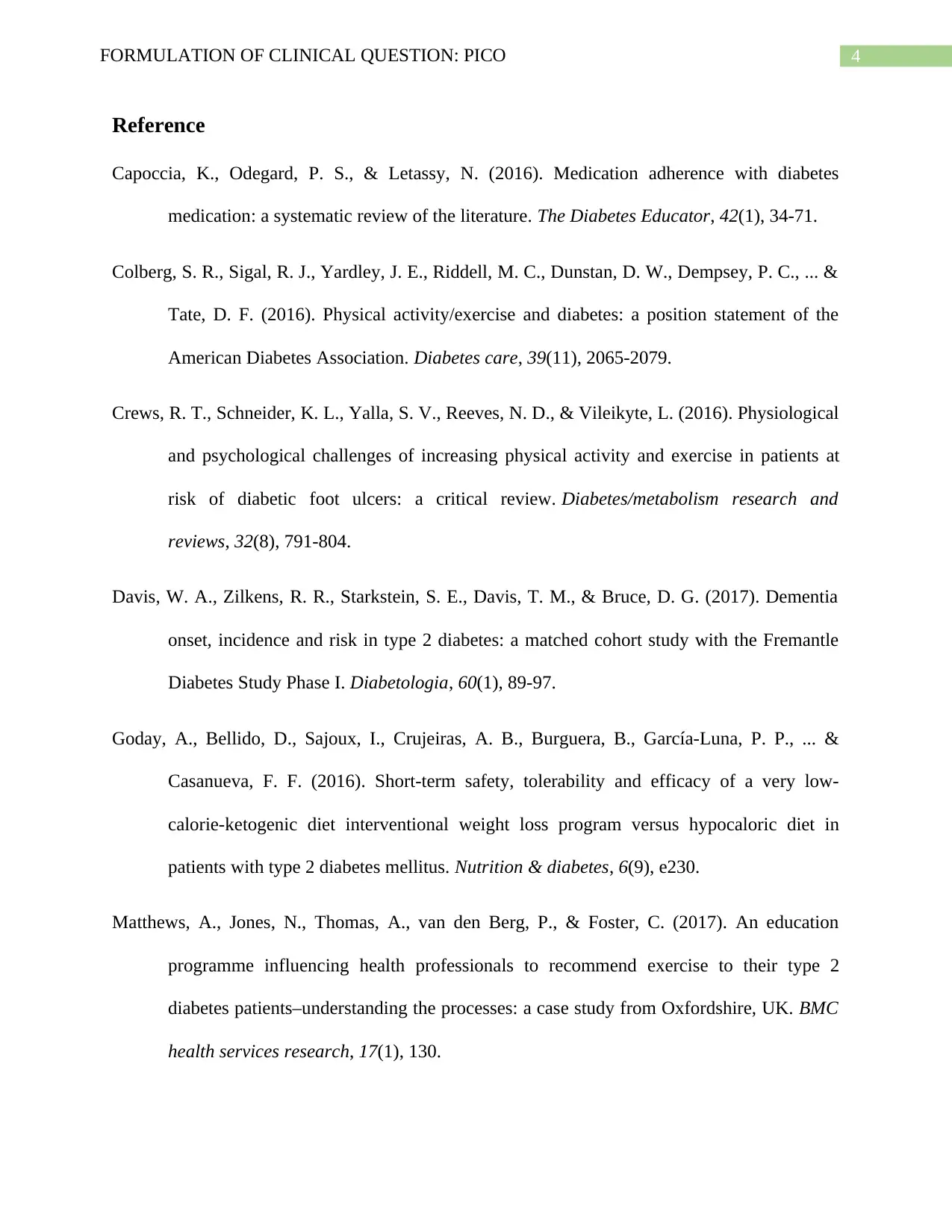
4FORMULATION OF CLINICAL QUESTION: PICO
Reference
Capoccia, K., Odegard, P. S., & Letassy, N. (2016). Medication adherence with diabetes
medication: a systematic review of the literature. The Diabetes Educator, 42(1), 34-71.
Colberg, S. R., Sigal, R. J., Yardley, J. E., Riddell, M. C., Dunstan, D. W., Dempsey, P. C., ... &
Tate, D. F. (2016). Physical activity/exercise and diabetes: a position statement of the
American Diabetes Association. Diabetes care, 39(11), 2065-2079.
Crews, R. T., Schneider, K. L., Yalla, S. V., Reeves, N. D., & Vileikyte, L. (2016). Physiological
and psychological challenges of increasing physical activity and exercise in patients at
risk of diabetic foot ulcers: a critical review. Diabetes/metabolism research and
reviews, 32(8), 791-804.
Davis, W. A., Zilkens, R. R., Starkstein, S. E., Davis, T. M., & Bruce, D. G. (2017). Dementia
onset, incidence and risk in type 2 diabetes: a matched cohort study with the Fremantle
Diabetes Study Phase I. Diabetologia, 60(1), 89-97.
Goday, A., Bellido, D., Sajoux, I., Crujeiras, A. B., Burguera, B., García-Luna, P. P., ... &
Casanueva, F. F. (2016). Short-term safety, tolerability and efficacy of a very low-
calorie-ketogenic diet interventional weight loss program versus hypocaloric diet in
patients with type 2 diabetes mellitus. Nutrition & diabetes, 6(9), e230.
Matthews, A., Jones, N., Thomas, A., van den Berg, P., & Foster, C. (2017). An education
programme influencing health professionals to recommend exercise to their type 2
diabetes patients–understanding the processes: a case study from Oxfordshire, UK. BMC
health services research, 17(1), 130.
Reference
Capoccia, K., Odegard, P. S., & Letassy, N. (2016). Medication adherence with diabetes
medication: a systematic review of the literature. The Diabetes Educator, 42(1), 34-71.
Colberg, S. R., Sigal, R. J., Yardley, J. E., Riddell, M. C., Dunstan, D. W., Dempsey, P. C., ... &
Tate, D. F. (2016). Physical activity/exercise and diabetes: a position statement of the
American Diabetes Association. Diabetes care, 39(11), 2065-2079.
Crews, R. T., Schneider, K. L., Yalla, S. V., Reeves, N. D., & Vileikyte, L. (2016). Physiological
and psychological challenges of increasing physical activity and exercise in patients at
risk of diabetic foot ulcers: a critical review. Diabetes/metabolism research and
reviews, 32(8), 791-804.
Davis, W. A., Zilkens, R. R., Starkstein, S. E., Davis, T. M., & Bruce, D. G. (2017). Dementia
onset, incidence and risk in type 2 diabetes: a matched cohort study with the Fremantle
Diabetes Study Phase I. Diabetologia, 60(1), 89-97.
Goday, A., Bellido, D., Sajoux, I., Crujeiras, A. B., Burguera, B., García-Luna, P. P., ... &
Casanueva, F. F. (2016). Short-term safety, tolerability and efficacy of a very low-
calorie-ketogenic diet interventional weight loss program versus hypocaloric diet in
patients with type 2 diabetes mellitus. Nutrition & diabetes, 6(9), e230.
Matthews, A., Jones, N., Thomas, A., van den Berg, P., & Foster, C. (2017). An education
programme influencing health professionals to recommend exercise to their type 2
diabetes patients–understanding the processes: a case study from Oxfordshire, UK. BMC
health services research, 17(1), 130.
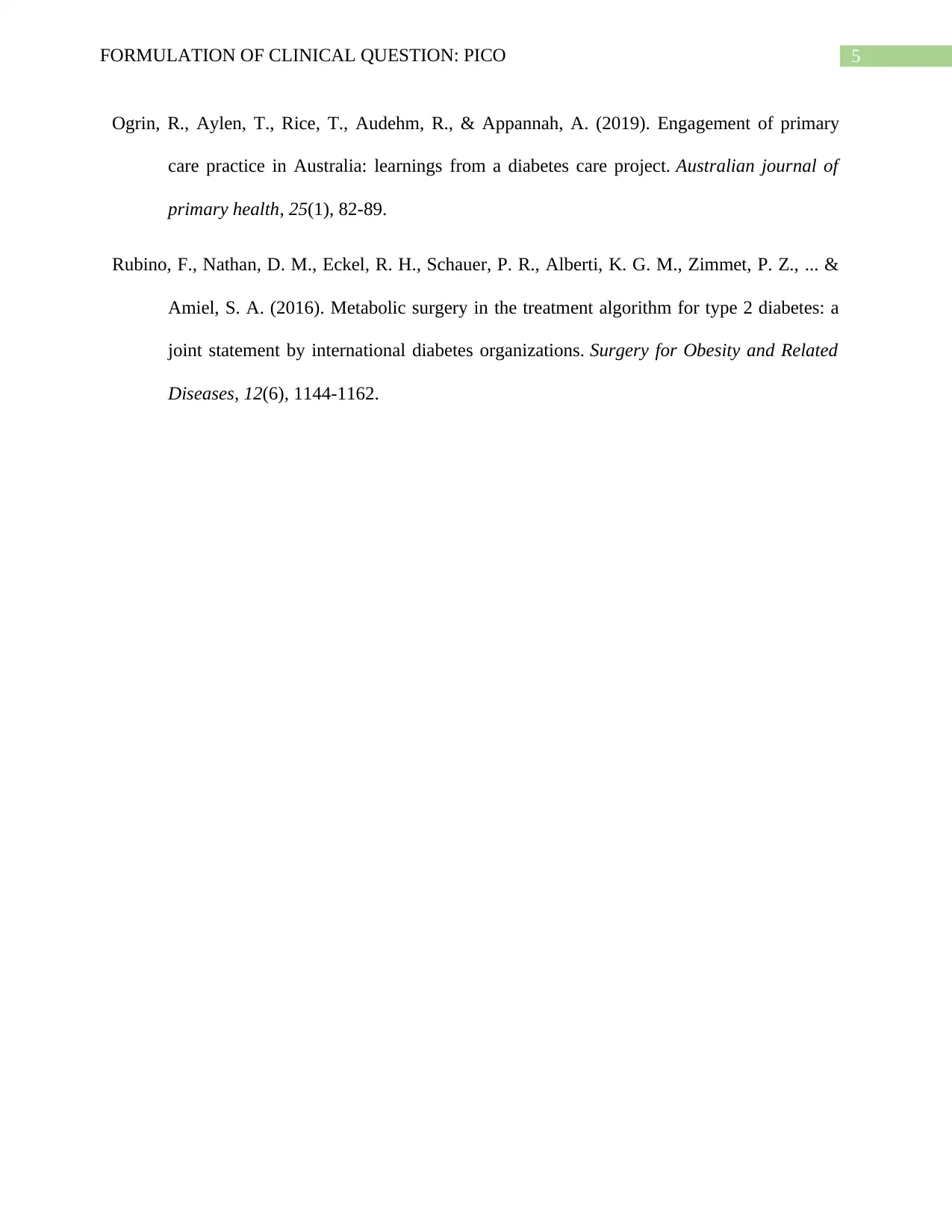
5FORMULATION OF CLINICAL QUESTION: PICO
Ogrin, R., Aylen, T., Rice, T., Audehm, R., & Appannah, A. (2019). Engagement of primary
care practice in Australia: learnings from a diabetes care project. Australian journal of
primary health, 25(1), 82-89.
Rubino, F., Nathan, D. M., Eckel, R. H., Schauer, P. R., Alberti, K. G. M., Zimmet, P. Z., ... &
Amiel, S. A. (2016). Metabolic surgery in the treatment algorithm for type 2 diabetes: a
joint statement by international diabetes organizations. Surgery for Obesity and Related
Diseases, 12(6), 1144-1162.
Ogrin, R., Aylen, T., Rice, T., Audehm, R., & Appannah, A. (2019). Engagement of primary
care practice in Australia: learnings from a diabetes care project. Australian journal of
primary health, 25(1), 82-89.
Rubino, F., Nathan, D. M., Eckel, R. H., Schauer, P. R., Alberti, K. G. M., Zimmet, P. Z., ... &
Amiel, S. A. (2016). Metabolic surgery in the treatment algorithm for type 2 diabetes: a
joint statement by international diabetes organizations. Surgery for Obesity and Related
Diseases, 12(6), 1144-1162.
⊘ This is a preview!⊘
Do you want full access?
Subscribe today to unlock all pages.

Trusted by 1+ million students worldwide
1 out of 6
Related Documents
Your All-in-One AI-Powered Toolkit for Academic Success.
+13062052269
info@desklib.com
Available 24*7 on WhatsApp / Email
![[object Object]](/_next/static/media/star-bottom.7253800d.svg)
Unlock your academic potential
Copyright © 2020–2025 A2Z Services. All Rights Reserved. Developed and managed by ZUCOL.





